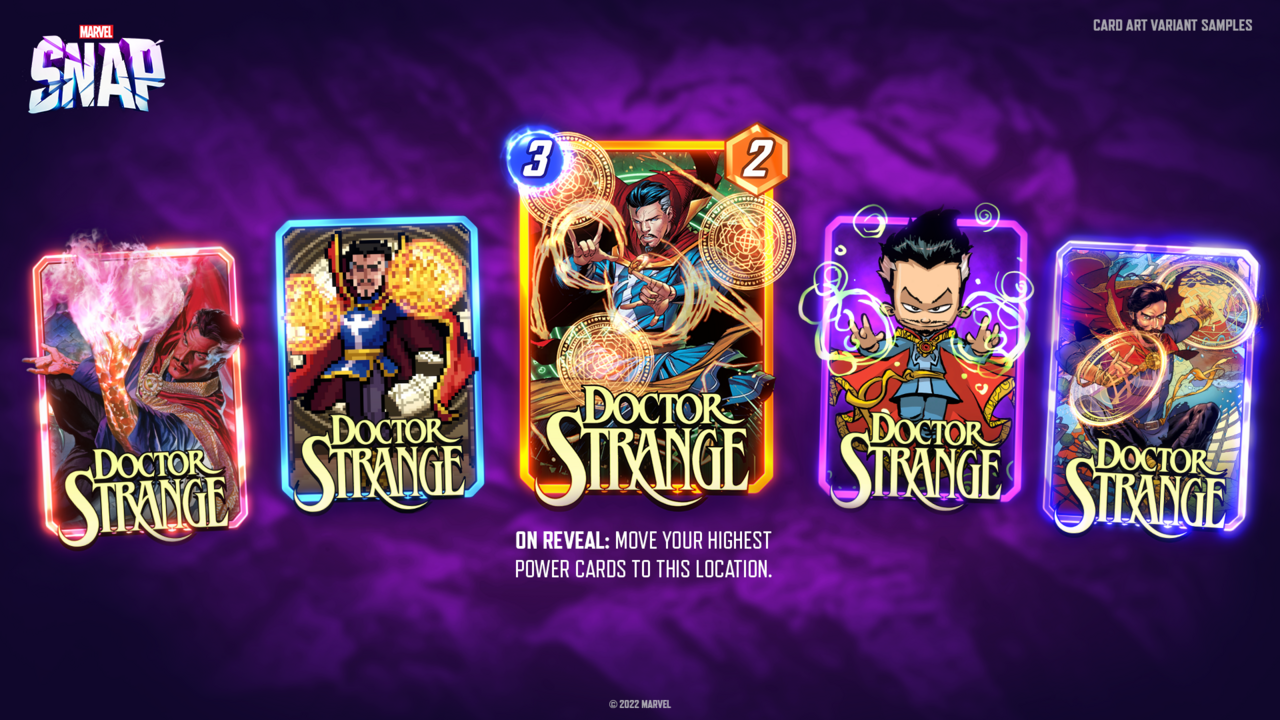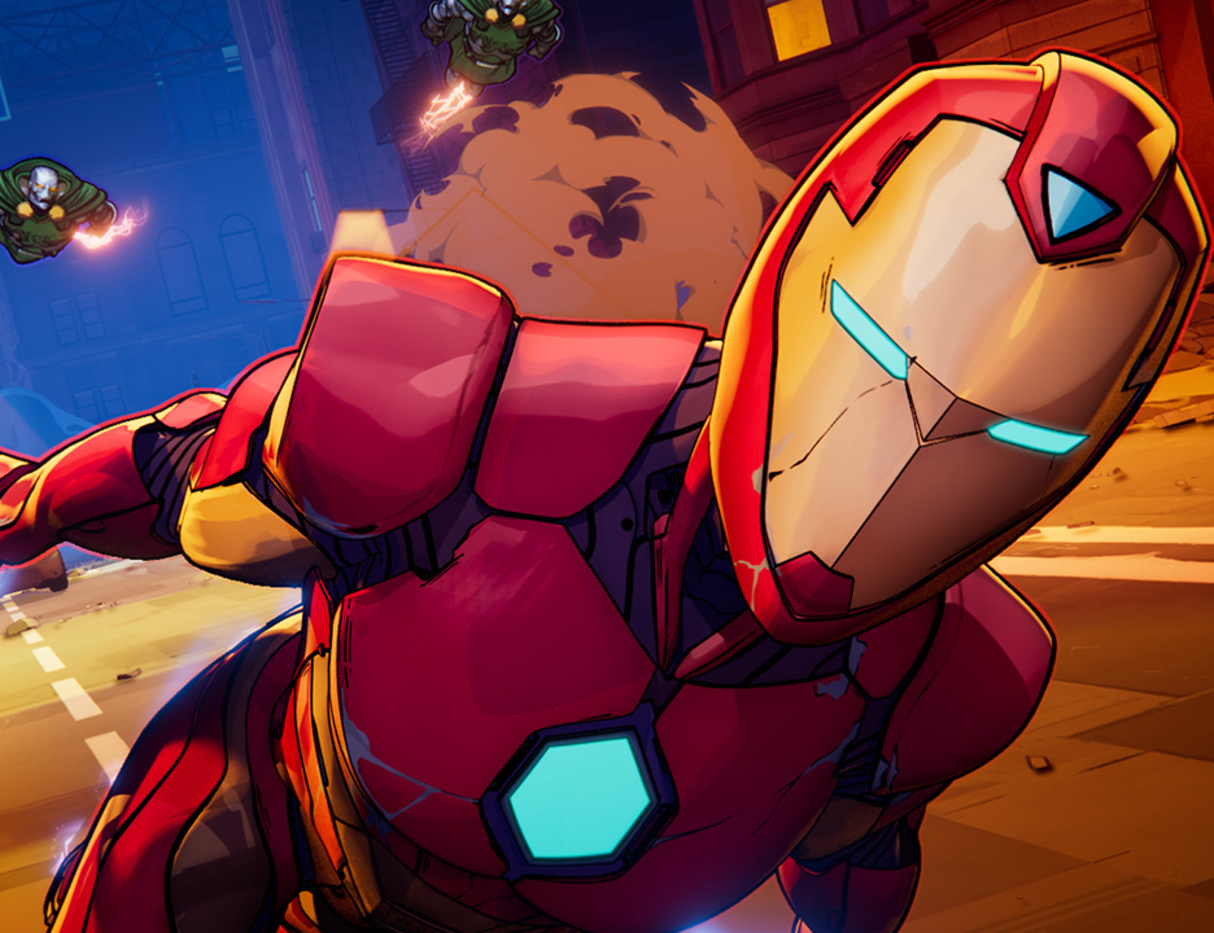The advent of digital collectible card games has led to an explosion of different approaches to the genre. Mostly, though, new games have adapted the fundamentals of physical CCGs. With Marvel Snap, Hearthstone veteran studio Second Dinner has reduced the collectible card game to its most essential pieces and reimagined them, creating a combination of systems that are elegantly simple without ever feeling simplistic.
Like many other modern card games, Marvel Snap automates its equivalent of mana or energy, adding one unit per turn. But then it streamlines the genre even further: Each game lasts only six turns, and there is no direct combat between characters or choosing whether to deal damage to enemy scrubs or “go face” for direct player damage. Instead, your goal is to accumulate the most power across three locations. At the end of six turns, whoever controls two of the three locations wins the match, and ties are determined by total power across all three.
Those three locations are randomly selected from a massive pool, each introducing their own intricacies and elements, and the areas range from the straightforward to the silly. The symbiote planet Klyntar will depower every card played on it, while NYC’s Central Park adds a 1-power squirrel to each other location. The locations are revealed from left to right over the first three turns. The random nature means you can be halfway through a match when a surprise third location completely shakes up your strategy, and sometimes you’ll need to gamble by blindly playing a hero into an unrevealed location.
The locations are, as you might expect, inspired by famous locales from the Marvel comics and cinematic universes. Westview, taken from the Marvel Cinematic Universe, changes into another random location on turn four, an homage to the story of WandaVision. Bruce Banner’s Gamma Lab turns every card into a Hulk, which can make for a big power swing if you manage to stash a lot of low-value cards there. These locations are some of the most inventive homages to Marvel canon, especially if you’re familiar enough with comics to recognize something like The Space Throne.
The hero cards themselves are built around Marvel mainstays as well, with similar but occasionally less inventive concepts than the locations. The vast majority of the cards are clever, creative envisioning of how to express the famous power sets of these heroes inside the medium of Marvel Snap’s mechanics. Iron Man, for example, doubles your power level at a location by equipping all your cards with an arc reactor. Captain America inspires his teammates, giving an ongoing boost to other cards wherever he is. And in a cute touch, Quicksilver always starts in your opening hand, as visualized by him arriving before all of your other cards. Half the joy of obtaining a new card is seeing how these famous heroes have been given a fitting power in the game. There are a handful of cards that feel like the game mechanic application came first and were then awkwardly mapped onto a hero, but those are rare exceptions.
And within those mechanics, Marvel Snap isn’t afraid to break its own rules. One location makes the game last seven turns instead of six. Another location sets the goal for its area of control as having the least power, so you might win by simply not playing anything there at all if your opponent accidentally plays or generates a card there. And sometimes, the game will surprise you with a completely unexpected curveball. At one point my game’s starting location was Ego, a living planet that takes over the game and plays both players’ decks for them. This essentially turned it into a two-sided A.I. match, and it was a hoot to watch. These wild situations seem engineered to come up only rarely, so they’re a delightful surprise when they do.
By making the game center around locations that are randomly assigned, no two games feel exactly the same, and it encourages thinking on your toes. In a traditional CCG, you build your deck around a game plan or win condition, and most games revolve around fending off your opponent and executing your plan. Marvel Snap certainly maintains that level of initial planning strategy, but the conditions on the field can change on a dime. You might end up winning in a completely different way than you had planned, simply by adapting and anticipating your opponent’s moves. And sometimes, for better and worse, the conditions on the field will render your plan functionally impossible to complete. I had built a deck around a big one-two punch on turns five and six–but found that’s unworkable when I happen to play a match that summons the Time Variance Authority location, which ends the game after turn four.
Even when a bad draw or strange location costs you the match, losing never feels too punishing. This is partly because the games themselves are so quick and, pardon the phrase, snappy. With a match only lasting a few minutes at most, it’s easy enough to shrug off a loss and queue into your next match, without having invested a significant amount of time. But it’s also because of another element, which provides the game its namesake.
Though the game seems to ease you in with bot matches presented like real opponents, it isn’t long before you’re taking on real opponents and competing for rank. In this case, rank is represented by Cosmic Cubes. It takes 10 Cubes to level up a rank, and each win grants you two Cubes by default. But at any point during a match, you or your opponent can “Snap”–doubling the wager to bet on yourself to win. If one player snaps and the game continues, you’re playing for four Cubes. If both players snap, you’re playing for eight. This introduces an element of bluffing, as you may want to hide your big game-swinging play for the very end, to lull your opponent into confidence enough to snap back and earn you more cubes. But it also means that you can Retreat at any time you don’t feel confident in the win. This is not just a standard concession–it actually saves you some cubes to retreat rather than continue with a match you’ll ultimately lose. Getting away from a doomed match having lost only one cube when your opponent wanted to raise the stakes to four actually feels like a relief, rather than a loss.
Shorter games also means smaller decks–only 12 cards in total–which makes deckbuilding more inviting and less intimidating. Even as a years-long player of Hearthstone, I often find building a deck of 30 or more cards difficult to wrap my mind around. In Marvel Snap, the deck size is so small that it’s easy to tinker with a deck, swapping out one less-used card for your latest find, sample it for a couple of lightning-quick games, and then tinker some more.
A similarly refined approach has been applied to its progression mechanics. The explosion of digital CCGs has by-and-large used the collection approach popularized by Magic, Pokemon, and similar physical card games years prior. You pay money for a random pack of cards and then use that to construct your deck. Marvel Snap breaks out of this paradigm in favor of a different form of CCG progression that is truly only available in a digital context. Instead of cracking open randomized packs of cards, you build your collection by visually upgrading your existing ones. You earn upgrade materials through play and then use those to upgrade cards with several tiers of visual effects: breaking out of the frame, a nifty 3D effect, an animated background, and so on. Upgrading those cards earns you “Collection Rank,” which progresses you along a path that earns you more upgrade materials and, most importantly, new cards. Then you can begin upgrading those new ones, and the process starts over again.

It’s a fiendishly compelling system that feeds into itself, and one that could easily have become predatory. So far, that isn’t the case. While anything is possible with a live game that will continue to add content for the foreseeable future, right now you can’t simply spend your way into all the best cards. Even if you had infinite money to spend, you can only purchase a handful of upgrade shortcuts per day, making it a fairly inefficient way to level up. The monetization strategy instead seems aimed mostly at purchasing variant art, like pixelated or baby versions of the characters. There’s so many of these it seems impossible to gauge how long it could take to collect them all, but it’s also a purely visual flourish.
The other monetization comes in the form of a season pass, which awards new cards, credits, and other bonuses for completing missions. In my experience so far, this is also surprisingly generous and low-impact. I was concerned that by coming in midway through the season I may not be able to finish the season pass in time and miss out on the best rewards. After only a few days I was already caught up and able to start pocketing the new missions as they progressively unlocked. Daily missions unlock on a regular timer every eight hours, and take just a few minutes to complete, and largely grant progress toward your season pass missions. This is a game that wants you to check in frequently for a little bit of time, not obsess over for hours at a time.
Though to be honest, it’s too late for that–I’ve already lost hours to Marvel Snap and I am obsessed. The game is fine-tuned, well-designed, and so easily digestible that it’s difficult to put down. I keep finding myself continuing to play even after having completed my daily or season pass missions, just because I want to play another match, or try a new card. Second Dinner has built an incredible foundation here, and I expect Marvel Snap will continue drawing me in for years to come.

